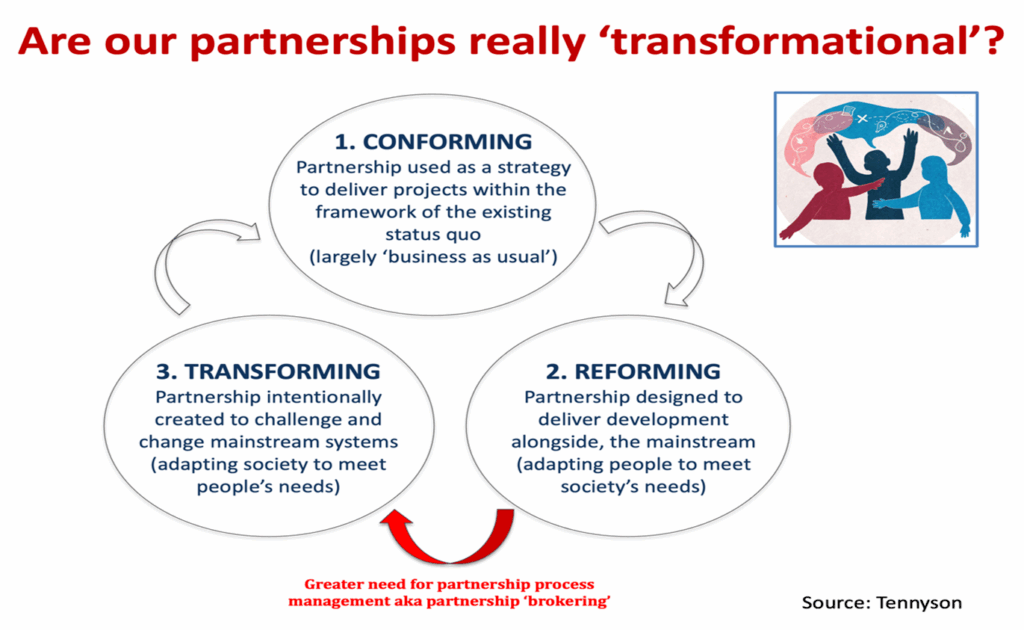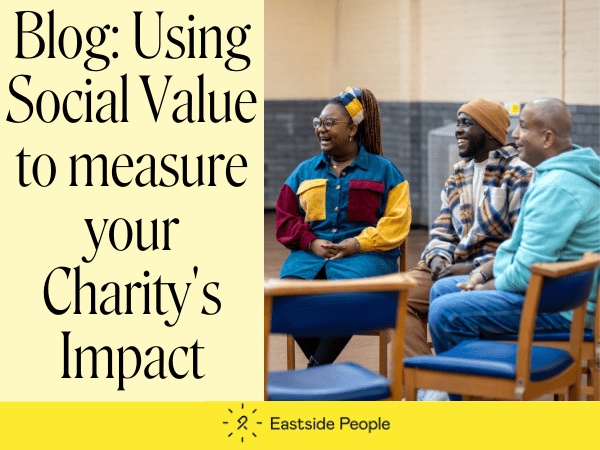We Said ‘Partnership’—But Did We Mean It?
A call for system-shifting collaboration in the UK third sector by: Dolyanna Mordochai, Charity Consultant and Interim CEO.
I’ve spent 26 years in the UK third sector, beginning as a volunteer and moving through roles as a frontline practitioner, manager, CEO, interim CEO, and now consultant. I’ve worked in partnerships across local, national, and international contexts, and I’ve seen both the power of genuine collaboration and the subtle pull of organisational self-protection. If I’m honest, I’ve done a bit of both.
In the UK third sector, “partnership” has become something of a Swiss Army knife, multi-purpose, within reach, and frequently over-promised. We see some brilliant examples of collaboration: initiatives that bring unlikely allies together, shift power, and create real, lasting change. But in my experience, these are still the exception, not the rule.
For the most part, partnership remains a convenient label for arrangements that are more about fundraising than transformation. Built around funding deadlines and driven by delivery requirements, many partnerships are transactional at heart. They tick the boxes but rarely shift the system.
Where Are Your Partnerships Located?

This slide, attributed to Ros Tennyson, points out that partnerships need to be differentiated and aligned with what prospective partners want to achieve through a collaboration. They’re not all the same. She distinguishes three basic types:
- Conforming partnerships refers to partnerships that operate within the status quo to deliver projects without challenging existing systems, such as a youth employability programme that helps young people write CVs and apply for jobs but does not question the structural barriers they face
- Reforming partnerships go a step further, aiming to improve how systems serve people. An example might be a collaboration between schools, local authorities, and charities to offer more accessible pathways into training or apprenticeships, still largely working within the established system
- Transforming partnerships are intentionally designed to shift power, challenge inequities, and reimagine the system itself. For example, a co-produced initiative where young people redesign the way services are delivered to them, challenging assumptions about success, agency, and who gets to decide.
The slide’s key message is that while many partnerships claim to be transformational, most operate in conforming or reforming spaces. Importantly, it also points out that the more transformational the goal, the greater the need for skilled partnership brokering to manage complexity, build trust, and support systemic change.
The Myths That Undermine Collaboration
Some of the biggest blockers to real partnership aren’t structural, they’re narrative. The stories we tell ourselves over and over again. The assumptions we rarely question. This framework was developed by Ros Tennyson in a World Bank project back in the 1990’s.
| Myth |
Truth |
| Partnerships are shaped around a common vision |
Partners often enter with their own organisational aims at the forefront |
| Partners are drawn together by shared goals |
They’re often drawn by complementary resources not unified intent |
| Partners know each other well; individual champions are enough |
Champions help, but without shared responsibility, they become bottlenecks |
| Partnerships work best when locally owned |
Local ownership matters, but can mask power dynamics |
| Ring-fenced partnerships are more likely to succeed |
Over-structuring can stifle flexibility and innovation |
| High partnership costs are off-putting |
The greater cost lies in failed or superficial partnerships |
| Value lies in replication or scaling |
The deepest value is in what partners learn and take back into their own systems |
Why Transactional Partnerships Persist
So why don’t more partnerships become system-shifting and stay transactional?
An obvious reason is that ‘transactional’ really works and is what is needed in many situations. Not all projects need to be transformational!
However, one significant reason why we don’t have enough system shifting partnerships is how they’re funded. When funding cycles are short and reporting requirements tight, there’s very little space to prioritise relationship-building. Understandably, many funders are under pressure themselves, to show value for money, track measurable results, and distribute limited resources fairly. Still, when funding structures focus primarily on outputs and “lead” organisations, they can unintentionally sideline the slower, more relational work that real collaboration requires.
There’s rarely time to explore values, power, or trust. Instead, we rush into bids, divvy up work, and spend months juggling misalignment no one ever had time to talk about. Delivery happens, but nothing shifts. No systems. No culture. No relationships strong enough to weather change. The intent to foster collaboration is often there, but without an investment in the process of partnering itself, the results are limited.
What Funders Can Do Differently
When funders want to support truly transformational collaboration, they must help create the conditions for effective and impactful collaboration. Support the early, messy phase of alignment. Fund the roles that nurture trust and hold space. Ask how power is being shared, not just what’s being delivered. Encourage feedback loops and reflection throughout the lifecycle of the partnership. Accept that meaningful collaboration evolves and so will the outcomes.
Some funders are already distinguishing between different types of partnerships, embedding trust-based approaches and being flexible in how success is defined. These practices should be celebrated, shared, and scaled.
The Dynamics We Avoid
According to NCVO’s Rebalancing the Relationship report (2021), many smaller charities involved in subcontracting arrangements report feeling marginalised and financially insecure. This sense of powerlessness can begin even before delivery, often surfacing during the opaque and centralised bidding process. One especially damaging practice is being used as “bid candy” where smaller partners are included in proposals to strengthen the lead bidder’s chances, only to be sidelined after contracts are secured. These dynamics don’t just undermine trust; they institutionalise extractive, rather than equitable, models of collaboration.
NPC’s State of the Sector research adds further context: 22% of charities admitted to delivering contracts outside their core mission. This mission drift isn’t always a strategic choice, it’s a survival mechanism in an environment of prolonged financial precarity. As one respondent put it:
“Our income goes down, but our costs are constant, forcing us to diversify more and more—often away from our core charitable aims, just to stay afloat.”
These structural pressures show up in partnership behaviours. I recently revisited a presentation on poor partnering dynamics. It didn’t just describe problems, it described meetings I’ve been in. Patterns I’ve seen. Patterns I’ve played into. Here’s what that looked like:
Poor Partnering behaviour
- A culture of ‘dumping’ – everyone leaving everything to everyone else
- All talk and no action – resulting in no outputs or impacts
- A ‘playing safe’ approach – partnership seen merely as a way of mitigating risk
- Unwillingness to have greater influence – on partner organisations, strategy or policy
- Over dependence on one or two individuals – failure to share and spread ownership
- Unresolved conflicts of interest – lack of honesty or willingness to address tough issues
- No/poor governance and accountability structures – individual partner priorities constantly taking precedence over partnership priorities
- Too much introspection – partnering for partnering sake, not enough focus on sustainable outcomes.
These behaviours don’t arise and persist because people don’t care. They arise in systems that deprioritize partnership-building (an explicitly attempt to share costs, risks and benefits) don’t fund time for alignment and rarely name or hold the tensions that inevitably arise.
Rethinking Leadership in Partnerships
At the recent ACEVO conference for charity CEOs, one of the speakers put it beautifully: “we need to put our collective mission whether that’s eliminating child hunger, reducing the suicide rate, or supporting those furthest from power, above our organisational ego”. And yet… why is that still so hard to do?
Leadership in partnership settings often defaults to whoever has the most resource, the strongest brand, or the loudest voice in the room. So that looks less like a partnership and more like hierarchy in disguise. Command-and-control or transaction only goes so far when it comes to addressing complex social, environmental and economic problems. There’s never enough resources. It’s certainly worth trying a different approach when it comes to transformation and system change.
The most effective leaders I’ve seen in collaborative spaces don’t fill the room, they open it. They listen more than they speak. They show vulnerability without turning it into a performance. They’re comfortable saying, “I don’t know,” and genuinely interested in what others see that they might have missed. That kind of leadership isn’t always loud, but it’s deeply felt. And in partnership work, it’s the difference between something that just functions and something that actually transforms. This isn’t always the leadership that gets recognised or rewarded. But it’s often the leadership that makes the biggest difference when it comes to building trust and enabling shared progress. Perhaps investing in better and more transformative partnering means investing in leaders – who we might call partnership brokers. Effective partnering does not just happen on its own. Successful cases always have someone driving or modelling good partnering behaviour.
Key Takeaways for CEOs:
- Not all partnerships are created equal: understand the spectrum, from transactional to transformative
- Not every partnership needs to be transformative : clarity of purpose matters more than ambition for depth
- Transformative partnerships require investment : they thrive on structured, intentional collaboration
- Success isn’t luck – effective partnering is a skill. It depends on giving people the space, support, and trust to build mutual value.
A Shared Responsibility for Better Partnership
If we want to move toward more transformative partnerships, we need to do it together. That means challenging the myths that hold us back, naming and working through difficult dynamics, creating funding models that prioritise relationships, and valuing the quiet, skilled work of brokering and facilitation. System-shifting partnerships don’t require perfect people or ideal conditions. They ask for a commitment to curiosity, to staying present in discomfort, and to doing the relational work needed to unlock lasting change. This is the work. And it’s worth doing.









